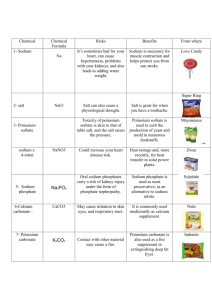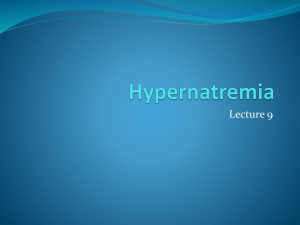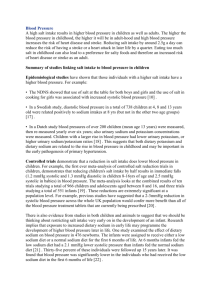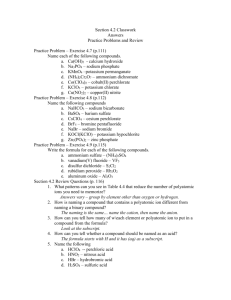Document 11186766
advertisement
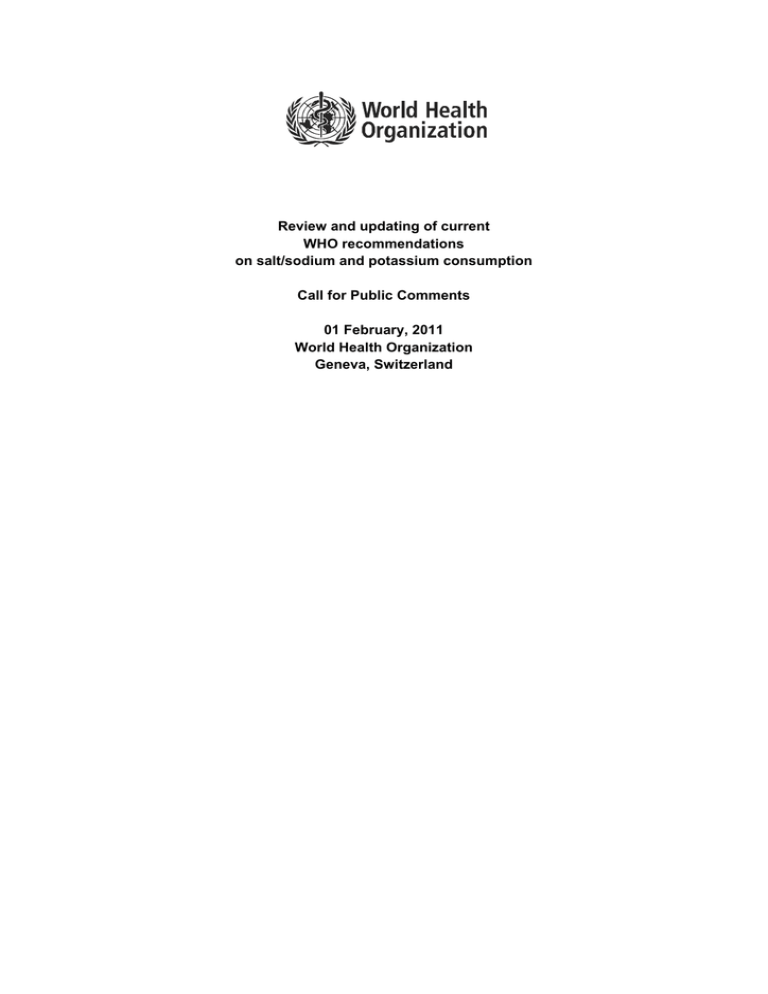
Review and updating of current WHO recommendations on salt/sodium and potassium consumption Call for Public Comments 01 February, 2011 World Health Organization Geneva, Switzerland 1. Justification: Noncommunicable diseases (NCDs) are the number one contributor to mortality and morbidity globally.(1) The major NCDs currently account for approximately 60% of all deaths and 43% of disease burden globally and these levels are expected to continue to rise.(1,2) In 2005, cardiovascular disease itself accounted for 30% of all deaths, the equivalent of infectious disease, nutritional deficiency, and maternal and perinatal conditions combined.(1) Sodium has been of interest in public health nutrition for decades predominantly due to its association with hypertension and cardiovascular diseases especially coronary heart disease and stroke. It appears from the majority of evidence that, for the majority of the individuals, the higher the sodium consumption, the higher their blood pressure will be.(3) High sodium consumption has also been linked to kidney disease, bone mineral loss and risk of osteoporosis, and certain types of cancers.(4,5) Low potassium intake is also associated with a number of NCDs. Increased potassium intake results in reduced blood pressure and may also result in decreased cardiovascular disease.(5,6) Potassium intake has also been associated with decreased risk of kidney stones and decreased calcium excretion in the urine indicating a potential benefit to bone mineral density and mass.(6) The most current WHO recommendation for the general population is to reduce the consumption of sodium to below 90 mmol (< 5g salt) per day.(7) This level was recommended to the WHO by a 2002 joint WHO/FAO Expert Consultation (5) and was later deemed appropriate and adopted as the recommendation on sodium consumption to prevent cardiovascular disease.(7) Most populations consume, on average, well above this recommended level and there is a plethora of evidence suggesting that decreasing sodium intake to this level could decrease blood pressure and risk of cardiovascular disease in most persons.(3) Nonetheless, a Cochrane Review on longer-term effects of salt reduction published in 2004 concluded that further benefits in blood pressure in both hypertensive and non-hypertensive individuals can occur with a further reduction of sodium intake to as low as 50mmol (3g salt) per day, thus raising the question of potential need to adjust the recommended level.(8) There is also evidence of increased effectiveness of decreased sodium intake on reducing hypertension in certain population subgroups; therefore, several normative agencies around the world have set alternative upper limits of sodium consumption for blacks, middle-aged, older, hypertensive, and overweight adults.(9,10) Currently, the WHO does not have a recommendation for specific groups based on ethnicity, age or other risk factors though current evidence may inform such recommendations. Similarly, WHO does not have specific recommendations for children and adolescents, however, in light of ever increasing burden of NCDs, even in younger persons, and recognizing that delaying incidence of NCD can contribute to delay in morbidity and mortality in older adulthood, a separate recommendation may be warranted.(1,5,7,11,12) The 32nd Session of the Codex Committee on Nutrition and Food for Special Dietary Uses (CCNFSDU) held in November 2010 made a special request to the WHO to consider the establishment of daily potassium intake values for the general population on the basis of dietary adequacy and/or reduction of NCD risk as part of the update of recommendations on salt/sodium intake. Based on an improvement in blood pressure and a blunting of the detrimental effects of higher sodium consumption on blood pressure, the 2002 joint WHO/FAO Expert Consultation recommended to the WHO that the general population consume a sufficient amount of potassium to maintain the molar ratio of sodium to potassium of 1:1 or approximately 70-80 mmol potassium per day.(5) The Institute of Medicine recommends a much higher level of adequate intake of 120.5 mmol based on evidence of benefits on blood pressure, risk of developing kidney stones and possibly decreased bone loss.(9) The latter two outcomes were not considered by the 2002 joint WHO/FAO Expert Consultation. In light of the publication of recent evidence regarding potassium and blood pressure and the association with renal function and bone loss, a current recommendation on potassium consumption should be explored. Diet during pregnancy is acutely important due to increased needs of the mother, the needs of the fetus, and the inherent health risks of pregnancy. Adequate salt/sodium intake is needed for a healthy pregnancy, however, hypertension during pregnancy is a very serious health risk. A meta-analysis of risk factors for pre-eclampsia,a condition that increases the risk of placental abruption and potentially fatal eclampsia, concluded that chronic hypertension and hypertension at first antenatal visit increase the odds of the pre-eclampsia and future cardiovascular disease.(13) Currently salt/sodium and potassium recommendations for the general population are also applied to pregnant women; however, specific recommendations may be warranted. The WHO has recognized the need to use a more rigorous process to ensure that public health recommendations are developed using the best available research evidence and preferably complemented with guidance on practical implementation. The objective of the review and updating of these recommendations on salt/sodium and potassium is to ensure that WHO recommendations are current and informed by the most recent scientific data and to consider recommendations for specific subgroups and based on diverse NCD outcomes. 2. Call for Public Comments The following are draft questions for defining the scope of the proposed review of evidence to be used to inform the recommendation development. Additionally, this document contains the draft PICO tables1 for recommendations on salt/sodium and potassium consumption. There will be a meeting of the WHO Nutrition Guidance Expert Advisory Group (NUGAG) Subgroup on Diet and Health in Geneva, Switzerland, 14 - 17 March, 2011. At that meeting, members of the NUGAG Subgroup on Diet and Health will prioritize the PICO questions and finalize the scope of the systematic review(s) which will inform the recommendation development on salt/sodium and potassium. In advance of the March meeting of the NUGAG Subgroup on Diet and Health, all interested parties are invited to comment on the scope of the proposed development/update of recommendations on salt/sodium and potassium consumption. The comments may be directly related to the draft scoping questions, the PICO tables, or general in nature. All public comments will be compiled, all changes to the scoping questions and/or PICO tables resulting from the public comment will be documented, and all information will be presented at the NUGAG meeting in March for review and consideration. These comments will inform the members of the NUGAG Subgroup on Diet and Health as they undertake the task of finalizing the scope of the WHO recommendations on salt/sodium and potassium consumption. 1 The PICO framework is useful to turn topics to be covered in a recommendation into answerable questions and describe the potential Population, Intervention/indicator, Comparator, and Outcomes. The PICO framework can help prioritize the scope of the recommendation and thus define the evidence retrieval for informing recommendation development. Draft scoping questions for recommendations on salt/sodium and potassium consumption 1) Guideline on the consumption of salt/sodium for the general population a: What is the upper limit of salt/sodium consumption that should be recommended for the general population to: reduce risk of elevated blood pressure reduce risk of cardiovascular disease reduce risk of renal disease/failure reduce risk of cancer reduce risk of osteoporosis/osteopenia/fracture b: Is the upper limit affected by: ethnicity gender area of habitation (hot/humid climate vs. not) suffering hypertension (vs. not) age (child, adolescent, adult, older adult, much older adult) 2) Guideline on the consumption of salt/sodium for pregnant women a: What is the upper limit of salt/sodium consumption that should be recommended for pregnant women to: reduce risk of elevated blood pressure reduce risk of pre-eclapsia reduce risk of poor fetal outcome b: Is the upper limit affected by: ethnicity gender area of habitation (hot/humid climate vs. not) suffering hypertension (vs. not) 3) Guideline on the consumption of potassium for the general population a: What is the recommended intake level of potassium to: reduce risk of elevated blood pressure reduce risk of cardiovascular disease reduce risk of renal disease/failure reduce risk of cancer reduce risk of osteoporosis/osteopenia/fracture b: Is the recommendation affected by: ethnicity gender area of habitation (hot/humid climate vs. not) suffering hypertension (vs. not) age (child, adolescent, adult, older adult, much older adult) source of additional potassium (diet vs. supplement) 4) Guideline on the consumption of potassium for pregnant women a: What is the recommended intake level of potassium for pregnant women to: reduce risk of elevated blood pressure reduce risk of pre-eclapsia reduce risk of poor fetal outcome b: Is the upper limit affected by: ethnicity gender area of habitation (hot/humid climate vs. not) suffering hypertension (vs. not) source of additional potassium (diet vs. supplement) 5) Guideline on the use of potassium substitutes to sodium for the general population a: Are potassium substitutes, when used to replace sodium, safe and effective to: reduce risk of elevated blood pressure reduce risk of cardiovascular disease reduce risk of renal disease/failure reduce risk of cancer reduce risk of osteoporosis/osteopenia/fracture b: If so, at what dose and frequency and in what chemical presentation? c: Is the recommendation affected by: ethnicity gender area of habitation (hot/humid climate vs. not) suffering hypertension (vs. not) age (child, adolescent, adult, older adult, much older adult) pregnancy Draft PICO table for salt/sodium consumption 1. Guideline on the consumption of salt/sodium for the general population What is the upper limit of salt/sodium consumption that should be recommended for the general population? Ranking Population: General population Subpopulations by age (0-6 m, 6-12 m, 1-1.99 yr, 2-4.99 yr, 5-6.99 yr, 7-9.99 yr, 1012.99 yrs, adolescent (13-17.99 yr), adult 18-59.99 yr), older adult (6079.99 yr), much older adult (>80 yr)) N/A by gender by ethnic group by area of habitation (hot/humid climates vs. not) by hypertensive status (diagnosed hypertensive vs. not hypertensive) by pregnancy status (pregnant women vs. non-pregnat women) Intervention: Varying levels of sodium intake N/A Subgroup analyses: Decreased intake of sodium through dietary change vs. usual intake Decreased intake of sodium through replacement vs. usual intake Comparator: Outcomes: No intervention or placebo or sodium replacement N/A Children/Adolescents 1.Blood pressure 2. Adverse events due to reduced salt/sodium intake Adults 1. Blood pressure 2. Cardiovascular disease 3. Renal disease/renal failure 4. Cancer 5. Osteoporosis/osteopenia/fracture 6. Adverse events due to reduced salt/sodium intake Older Adults: 1. Blood pressure 2. Cardiovascular disease 3. Renal disease/renal failure 4. Cancer 5. Osteoporosis/osteopenia/fracture 6. Adverse events due to reduced salt/sodium intake Much Older Adults: 1. Blood pressure 2. Cardiovascular disease 3. Renal disease/renal failure 4. Cancer 5. Osteoporosis/osteopenia/fracture 6. Adverse events due to reduced salt/sodium intake Pregnant women 1. Blood pressure 2. Pre-eclapsia 3. Eclapsia 4. Poor fetal outcome 5. Adverse events due to reduced salt/sodium intake Setting All countries N/A Draft PICO tables for potassium consumption 2. Guideline on the consumption of potassium for the general population What is the recommended intake of potassium for the general population? Ranking Population: General population Subpopulations by age (0-6 m, 6-12 m, 1-1.99 yr, 2-4.99 yr, 5-6.99 yr, 7-9.99 yr, 10-12.99 yrs, adolescent (13-17.99 yr), adult 18-59.99 yr), older adult (60-79.99 yr), much older adult (>80 yr)) N/A by gender by ethnic group by area of habitation (hot/humid climates vs. not) by hypertensive status (diagnosed hypertensive vs. not hypertensive) Intervention: by pregnancy status (pregnant women vs. non-pregnat women) Varying levels of potassium intake N/A Subgroup analyses: Increased intake of potassium through dietary change vs. usual intake Increased intake of potassium through replacement vs. usual intake Increased intake of potassium through supplementation vs. no Comparator: Outcomes: No intervention or placebo N/A Children/Adolescents 1.Blood pressure 2. Adverse events due to increased potassium intake Adults 1. Blood pressure 2. Cardiovascular disease 3. Renal disease/renal failure 4. Cancer 5. Osteoporosis/osteopenia/fracture 6. Adverse events due to increased potassium intake Older Adults: 1. Blood pressure 2. Cardiovascular disease 3. Renal disease/renal failure 4. Cancer 5. Osteoporosis/osteopenia/fracture 6. Adverse events due to increased potassium intake Much Older Adults: 1. Blood pressure 2. Cardiovascular disease 3. Renal disease/renal failure 4. Cancer 5. Osteoporosis/osteopenia/fracture 6. Adverse events due to increased potassium intake Pregnant women 1. Blood pressure 2. Pre-eclapsia 3. Eclapsia 4. Poor fetal outcome 5. Adverse events due to increased potassium intake Setting All countries N/A Literature Cited (1) World Health Organization. Preventing chronic disease: A vital investment. Geneva . World Health Organization. 2005. (2) Strong K, Mathers C, Leeder S, Beaglehole R. Preventing chronic diseases: how many lives can we save? Lancet 2005;366:1578–82. (3) Mackay J, Mensah G. Atlas of Heart Disease and Stroke. Geneva, World Health Organization. 2004. (4) He FJ, MacGregor GA. A comprehensive review on salt and health and current experience of worldwide salt reduction programmes. J Hum Hyperten. 2009;23(6):363-84. (5) World Health Organization. Diet, nutrition and the prevention of chronic disease. Report of a Joint WHO/FAO Expert Consultation. Geneva, World Health Organization, 2003 (WHO Technical report series, No. 916) (6) 2005 Dietary Guidelines Advisory Committee. The Report of the Dietary Guidelines Advisory Committee on Dietary Guidelines for Americans, 2005. Department of Health and Human Services and Department of Agriculture. Washington DC. 2004. available at http://www.health.gov/dietaryguidelines/dga2005/report/default.htm. (7) World Health Organization. Prevention of Cardiovascular Disease: Guidelines for assessment and management of cardiovascular risk. Geneva. World Health Organization. 2007. (8) He FJ, MacGregor GA. Effect of longer-term modest salt reduction on blood pressure. Cochrane Database of Systematic Reviews. 2004. issue 1. Art. No.:CD004937.DOI:10.1002/14651858.CD004937. (9) Institute of Medicine. Dietary reference intakes: water, potassium, sodium, chloride, and sulfate. National Academy Press, Washington,DC, 2004. (10) National Health and Medical Research Council. Nutrient Reference Values for Australia and New Zealand Including Recommended Dietary Intakes. Canberra. 2006. (11) Scientific Advisory Committee on Nutrition. Salt and Health. The Stationary Office. London. 2003. (12) Uauy R, Dangour AD. Fat and fatty acid requirements and recommendations for infants of 0-2 years and children of 2-18 years. Ann Nutr Metab 2009;55:76-96. (13) Duckitt K, Harrington D. Risk factors for pre-eclampsia at antenatal booking: systematic review of controlled studies. BMJ 2005; 330:565-72.


